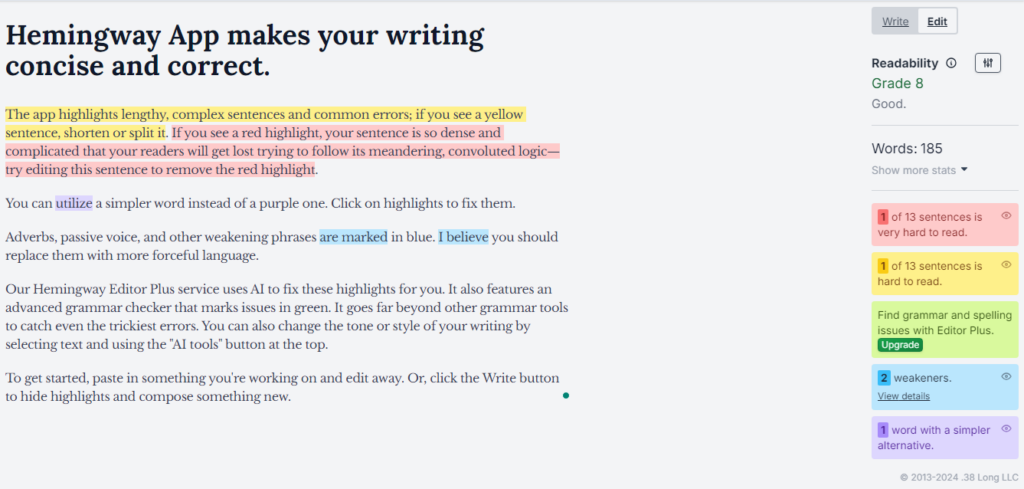The AI craze doesn't seem to be stopping any time soon. With technological advancements and our reliance on tools, AI grammar checkers are never in more demand. We use these tools for anything from marketing and advertising to writing. In fact, 35% of companies are actively using AI tools in day-to-day business operations.
Many companies use these tools for spellchecking, proofreading, and similar grammar inconsistencies. It is because of this that businesses must discover the best of the best. However, with so many tools out there, choosing the best one goes far beyond a simple Google search.
Fortunately, our top 10 AI grammar checkers guide outlines the tools best equipped to help you handle such inconsistencies. Let's dive in and discover what these tools are, what they can do, and give you the rundown to save time.
What Are AI Grammar Checker Tools?
AI grammar checker tools are advanced applications that utilize artificial intelligence and natural language processing to enhance your writing. These tools analyze your text for spelling, grammar, punctuation, and style issues, providing corrections and suggestions to improve clarity and coherence.
When you use an AI grammar checker, it can identify complex errors that traditional spell checkers might miss, such as awkward phrasing or incorrect word order. This is particularly beneficial for non-native speakers who may struggle with nuanced English grammar. Integrating these tools into your marketing toolset can bring a host of benefits, which we'll discuss a bit later.
Summary of the Best 5 AI Grammar Checker Software
- Grammarly: Best for comprehensive grammar checking and writing style customization, including plagiarism detection and inclusive writing features.
- Linguix: Best for simplifying and enhancing content with advanced rewriter tools and templates, tailored to audience readability and writing goals.
- ProWritingAid: Best for in-depth writing style reports and real-time suggestions to improve clarity and reduce redundant phrases.
- Hemingway: Best for tightening copy and simplifying complex sentences, offering a straightforward, color-coded interface.
- Slick Write: Best for detailed, customizable writing analysis across various aspects of language, with a free, versatile toolset.
Top 10 AI Grammar Checkers
1. Grammarly

Probably the most popular grammar and spelling checker online, Grammarly offers tools that empower individual writing or produce a unified brand voice across your whole organization through its customizable style guides. Before you start writing, the platform asks you to set goals and define:
- Your audience (general, knowledgeable, or expert)
- The formality of language/tone (formal, informal, or neutral)
- Domain (general, academic, business, email, casual, or creative)
- Intent (describe, inform, convince, or tell a story)
Grammarly also supports inclusive writing, sending the notification “Potentially sensitive term” when your word choice might offend or disrespect some groups.
Grammarly features plagiarism detection and citation support. The company’s partner, ProQuest, gives Grammarly users access to its databases of journals, newspapers, and other references to spot any plagiarism and ensure your final document is considered original.
The platform’s infrastructure ensures the privacy of your content through data encryption and other security certifications. The free version includes conciseness checks, tone detection, and readability scoring, besides spelling, grammar, and punctuation. Meanwhile, Premium plan holders enjoy everything in the free plan, plus word choice, full-sentence rewrites, tone suggestions, and citation generation. Grammarly suggests the Business plan for enterprises to access style guides, brand tones, snippets, the analytics dashboard, and more.
2. Linguix

Linguix claims to reduce editing and approval time for web content and email newsletters by as much as 68% with its grammar checker and “rewriter.” You can highlight a passage you want to improve, click the colored pencil (Linguix’s icon), and the platform will generate a list of alternative sentences that convey that same thought. Linguix also offers advanced writing suggestions, from deleting overused words and clichés to simplifying sentences.
Even the best writers experience mental block. Linguix can help with that, providing templates that can spark inspiration and break off the inertia of rest. You can also refer to the Linguix dictionary or use the platform’s synonyms tool to make your writing sound less monotonous.
Like Grammarly, Linguix has an audience tool where you can choose traits to match your content’s readability with that of your readers (general, knowledgeable, academic, specialist, or genius). You also select the goal of your writing (storytelling, “share info,” promotion, or call to action) and your preferred emotion (calm or exciting). Moreover, the platform shows your readability score and document stats (total word count, average word and sentence length, and so on).
Linguix has browser extensions for Chrome, Firefox, Google Docs, Safari, Edge, MS Word, and MS Outlook. Moreover, the tool is available on mobile and has free and paid plans. Business plan subscribers can create their style guides for their brand voice.
3. ProWritingAid

ProWritingAid’s unique selling point is its writing style report, which lists as many as 20 areas that need improvement. You will find a tally of redundant phrases or sentence starts, overused words, long-winding sentences, passive verbs, and clichés. It also notes inconsistencies in the type of English used, capitalization, spelling, punctuation, and acronyms. The report also covers pronoun use, homonyms (“He lost his patients”), transitions, pacing, dialogue tags (words preceding a quoted line such as “said” or “exclaimed”), and alliteration.
The platform offers real-time, quick fixes, including style suggestions that produce clearer and more impactful writing. Meanwhile, you can use ProWritingAid’s Word Explorer and contextual thesaurus to find the most suitable words for your ideas.
Free and expert plans are available. You can get basic writing suggestions for up to 500-word documents and 10 rephrases a day when you use ProWritingAid’s free version. For plagiarism-free content checking, try the Expert plan.
4. Hemingway

Hemingway lets you get down to work immediately, with its homepage welcoming you to a blank page where you can write or copy-paste your content. The right side of the interface offers a color-coded summary of your performance: blue for adverb use, green for passive voice, pink for complicated phrases, yellow for long sentences, and peach for complex sentence structure.
You will find your readability score (US grade level) on top of that right column. The reading time length, word count, and number of sentences and paragraphs are also found there. Scoring can go down as low as 5th grade, although the platform notes that the average American reads at the 10th-grade level.
Hemingway is an effective tool for tightening your copy. It may not be advisable for non-commercial content such as manuals, novels, or textbooks.
You can use it offline for desktop through a paid subscription. Hemingway has no plug-ins or extensions at the moment.
5. Slick Write

Slick Write is a free, all-around tool for content marketers, novelists, students, and job applicants. Each editing session can accommodate up to 30,000 words.
On the Editor page, click the Settings icon on the left side to open the Analysis feature. Here, choose the aspects of your writing that Slick Write must check. The platform offers analysis for:
- The basics: capitalization, doubled words (or words used twice in a row), extra spaces, and commonly confused words
- Sentences: starting with the same word, long sentences, excessive prepositional phrases, transition words and phrases, recycled or redundant linking verbs, misplaced conjunctions, and misplaced prepositions
- Concise language: hidden verbs or wordy substitutes for verbs, filter words (or verbs that describe an experience from someone else’s viewpoint: “Olivia took a shower when she realized she smelled bad.”), legalese, wordiness, double negatives, and more
- Professional language: slang, cliches, split infinitives, gender-specific pronouns, weak descriptions (“Her dress was long and it touched the floor” versus “Her long dress touched the floor.”), and more
- Honesty and objectivity: weasel words (or abstract words that lack specificity), biased language, and third-person pronouns
Click the pencil or edit icon to type or paste your content. Once the tool scans your document, the view switches to Critique mode. This mode allows you to view your copy in four ways: the Feature view shows the words or phrases you must revise. Note that Slick Write doesn’t auto-suggest replacements for errors. Meanwhile, the Structure view identifies your sentences by length (simple, compound, and compound-complex). The Quotes and Vocabulary views also provide more insights into your writing style.
You get your stats in a list and graphical form. The platform has Chrome and Firefox extensions. It also integrates with WordPress, Open Office, and Libre Office.
6. Scribens

Scribens prides itself in detecting grammar errors 10x better than Microsoft Word’s built-in checker. The platform is comparable with standard grammar checkers in that it highlights the words that need correcting and explains the grammar rule when you click on the highlighted word.
Scribens detects redundancies and run-on sentences and suggests alternative words for your document with the help of its built-in dictionary. To easily distinguish corrections, the tool underlines punctuation errors in blue. Meanwhile, wrong verb forms are underlined in green. Other grammar mistakes will have red lines.
Its writer’s report, which appears on the left panel of the screen, shows your performance in three areas: style (redundancies, vocabulary enhancement, subjectivity that lists words with a positive and pejorative connotation), suggested synonyms, and stats (including Flesch and Gunning Fog readability indices). Once you’ve corrected your content, you can save it as a .txt, .odt, or .docx file.
Enjoy the Scribens extension for web-based use, office tools, and mobile when you sign up for a premium plan. You can also perform grammar checks for up to 50 pages with a paid subscription.
7. GrammarCheck

GrammarCheck offers a clean interface where you can upload your content. The tool recognizes various types of English (UK, Canadian, Australian, New Zealand, South African, and even AI-based English). GrammarCheck highlights spelling errors in red and grammar mistakes in blue. For more intensive proofreading, click the Deep Check button to surface dangling modifiers, incorrect tenses, style issues, and plagiarism.
The platform has no reporting feature, so you can only edit your work on the website. To perform the grammar check, click the “Check Your Text” tab to start typing or copy-paste the document onto the blank space.
8. Sapling

Sapling is a writing assistant designed for creating grammatically correct content in live chat or messaging platforms. The platform also helps craft concise and straightforward emails and social media posts. Hence, customer-facing teams in eCommerce, gaming, and logistics can benefit the most from this tool in a fast-paced environment where customers say they needed answers “yesterday.”
Moreover, you can use Sapling’s response bank to store replies to customers and partners. You and your team can later turn to this database to pull out a message relevant to your current situation. Free, pro ($25 per month), and enterprise (customized rate) plans are available.
9. Ginger

Ginger’s powerful Rephraser tool generates up to eight other versions of your original sentence, allowing you to discover and choose the most effective way to convey your message. Unlike other grammar checkers, the platform has a “Correct All” feature that lets Ginger auto-correct all the mistakes in one sentence or paragraph in one sweep.
Moreover, this tool’s various grammar-focused features will delight nit-picky writers. On the “Complete Ginger Grammar Book” webpage, you’ll find the different parts of speech plus comma use with clickable tabs detailing the rules. Ginger also has sections where you can verify commonly misspelled and confusing words.
You can use the platform—which has free and paid subscriptions—via browser extension, desktop app, or mobile app. Ginger allows Premium plan holders to pay monthly, quarterly, annually, or bi-annually. Meanwhile, the Ginger Business plan can cover up to 100,000 team members.
10. Trinka

Trinka is geared toward technical and academic writing, providing users with features to check various aspects of formal documents. The platform checks technical spelling and word choice, proper usage of APA or AMA style guides, and industry-specific tone and language. Its users include Harvard Medical School, Princeton University, Yale, and Cornell University.
To make your writing publication-ready, Trinka goes through your document using over 20 checkpoints, including:
- Technical phrasing so you can pick the appropriate terms that readers in your field can relate to
- Unbiased language by identifying and suggesting replacements for biased and insensitive language
- Word count reduction by showing areas of redundancy and wordiness
- Achieving an academic tone by suggesting formal words in place of casual terms
Trinka also helps reduce the possibility of journal rejection with its “Journal Finder” tool. The platform shows you how you can align your writing with the standards of your target publication. Journal Finder can also recommend a journal where you can pitch your paper after understanding the concepts discussed in your manuscript.
The writer’s suite includes a plagiarism checker powered by iThenticate, an auto file editing tool that revises your entire document in minutes. Once Trinka is done editing, you can download your manuscript showing markings for the revised sentences. Meanwhile, the Citation Checker analyzes your citations to ensure your paper contains only credible sources that can strengthen your argument. Trinka also checks for consistency, saves your brand or technical terms in its personal dictionary, and stores the “track changes” or edits on your document.
Trinka has a free basic plan (10,000 words per month) and a paid premium plan (unlimited words and higher credits for Plagiarism Check, Auto File Edit, Journal Finder, and Citation Checker). Its plug-in works on Twitter, LinkedIn, Google Docs, ResearchGate, Authorea, Evernote, Medium, and more.
Why Use AI Grammar Checkers?
Here are 5 compelling reasons to use AI grammar checkers to improve your writing:
Catch Errors Automatically
AI grammar checkers analyze your text in real time, identifying spelling mistakes, incorrect punctuation, and grammatical errors that you may have overlooked. For example, Grammarly automatically flags issues such as missing commas, subject-verb agreement errors, or incorrect word usage as you write. This instant feedback helps you produce cleaner, more polished writing without the tedious process of manual proofreading.
Check out the example below to get a sense of how Grammarly works.
Enhance Clarity and Conciseness
Beyond just fixing errors, AI tools provide suggestions to enhance the clarity and conciseness of your writing. For instance, Linguix offers advanced writing suggestions, such as deleting overused words and simplifying sentences, making your content more engaging. Hemingway also highlights complex sentences and suggests ways to break them down, ensuring that your writing is clear and easy to read.
Adapt to Your Writing Style
The best AI grammar checkers are highly customizable, allowing you to tailor their feedback to your unique writing style and goals. Grammarly lets you set goals based on your audience, formality, domain, and intent, ensuring that the suggestions align with your intended voice. Similarly, ProWritingAid provides detailed style reports and suggestions that can be adjusted based on the type of writing you're doing, whether it's creative, academic, or business-oriented.
Improve Over Time
AI grammar checkers continuously learn from the writing they analyze, refining their understanding of language and providing more accurate feedback over time. ProWritingAid adapts to your preferences as you accept or reject its suggestions, helping you develop better writing habits. With consistent use, these tools act like personal writing coaches, offering increasingly tailored advice that helps you improve your skills over time.
Save Time and Effort
Manually proofreading and editing your work is a time-consuming process. AI grammar checkers automate much of this work, allowing you to quickly identify and fix issues. For example, Slick Write can scan up to 30,000 words in a single session, providing detailed analysis on various aspects of your writing, from sentence structure to the use of clichés.
This frees up your time and mental energy to focus on the creative aspects of writing rather than getting bogged down in the details. With an AI tool in your corner, you can write more efficiently and confidently.
Tips to Help You Pick the Right AI Grammar Checker Tool
Here are five tips to help you pick the right AI grammar checker tool for your writing needs:
Identify Your Specific Needs
Before selecting a grammar checker, consider what you need it for. Are you writing academic papers, business emails, or creative content? Different tools cater to different styles. For example, ProWritingAid offers detailed style reports ideal for creative and professional writing, while Grammarly is versatile and works well across various formats. Understanding your primary writing context will help you choose a tool that aligns with your goals.
Evaluate Features and Capabilities
Look for tools that offer a range of features beyond basic grammar checks. Some tools provide style suggestions, tone detection, and even plagiarism checks. For instance, Linguix offers advanced writing suggestions and templates, while Grammarly includes real-time corrections, tone adjustments, and vocabulary enhancement suggestions. Assess which features are most valuable to you based on your writing objectives.
Consider User Experience and Interface
A user-friendly interface can significantly enhance your experience. Choose a grammar checker that is easy to navigate and integrates seamlessly with your writing platforms, such as Google Docs or Microsoft Word. Tools like Linguix and Grammarly are known for their intuitive designs, making it easier for you to focus on writing rather than struggling with the software.
Check for Customization Options
The ability to customize the tool to fit your writing style is crucial. Some grammar checkers allow you to set preferences based on the type of writing, audience, and tone. This ensures that the feedback you receive is relevant and tailored to your needs. Tools like Grammarly let you adjust settings according to your writing goals, helping you maintain your unique voice.
Test Free Versions or Trials
Most AI grammar checkers offer free trials or basic versions. Take advantage of these to test the tool's effectiveness before committing to a subscription. This hands-on experience will allow you to assess how well the tool meets your needs and whether it enhances your writing process. Tools like ProWritingAid and Grammarly offer free options, making it easier to find the right fit without financial commitment.
Optimize Your Content with an AI Grammar Checker
Marketers and creators can’t afford any dissonance resulting from grammatical errors in their written content. Clean and readable copy hooks prospects and delights customers to repeatedly return to your website, social channel, agency, or brick-and-mortar store. Moreover, checking your content for grammar adds to a brand’s credibility and authority.
What more does it take to have impactful content? Know the best practices for content writing and copywriting by reading our two guides on these subjects: “What Is Content Writing? (+ How to Excel At It In 2024)” and “13 Best Copywriting Practices – Writing for the Web in 2024.”
Frequently Asked Questions
What is the highest-rated grammar checker?
Grammarly is often considered the highest-rated grammar checker due to its comprehensive features, user-friendly interface, and versatility across different writing contexts. It not only checks for grammar, spelling, and punctuation errors but also offers advanced suggestions for style, tone, and clarity. Grammarly's ability to integrate with various platforms like Microsoft Word, Google Docs, and web browsers, along with its robust plagiarism detection feature, makes it a popular choice among professionals, students, and casual writers alike.
Is there an AI-based spell checker?
Yes, there are several AI-based spell checkers available, with Grammarly being one of the most popular options. AI-driven spell checkers like Grammarly and ProWritingAid go beyond simple spell-checking by analyzing context, suggesting word alternatives, and even correcting commonly confused words. These tools continuously learn and adapt, providing increasingly accurate and context-aware corrections over time, making them highly effective for enhancing both spelling and overall writing quality.
What is the AI that enhances grammar?
Grammarly is one of the leading AI tools that enhances grammar. It uses advanced algorithms and machine learning to analyze text in real-time, offering suggestions to improve grammar, punctuation, sentence structure, and style. Tools like ProWritingAid and Linguix also employ AI to provide in-depth grammar and writing style enhancements, making them powerful options for anyone looking to refine their writing.
Can ChatGPT check grammar?
Yes, ChatGPT can check grammar and offer suggestions for improvement. While its primary function is as a conversational AI, it is also capable of analyzing text, identifying grammatical errors, and providing advice on how to correct them. However, for more specialized and detailed grammar checking, tools like Grammarly or ProWritingAid may offer more comprehensive features, as they are specifically designed for that purpose. ChatGPT can be a useful supplementary tool for quick checks and basic corrections.





